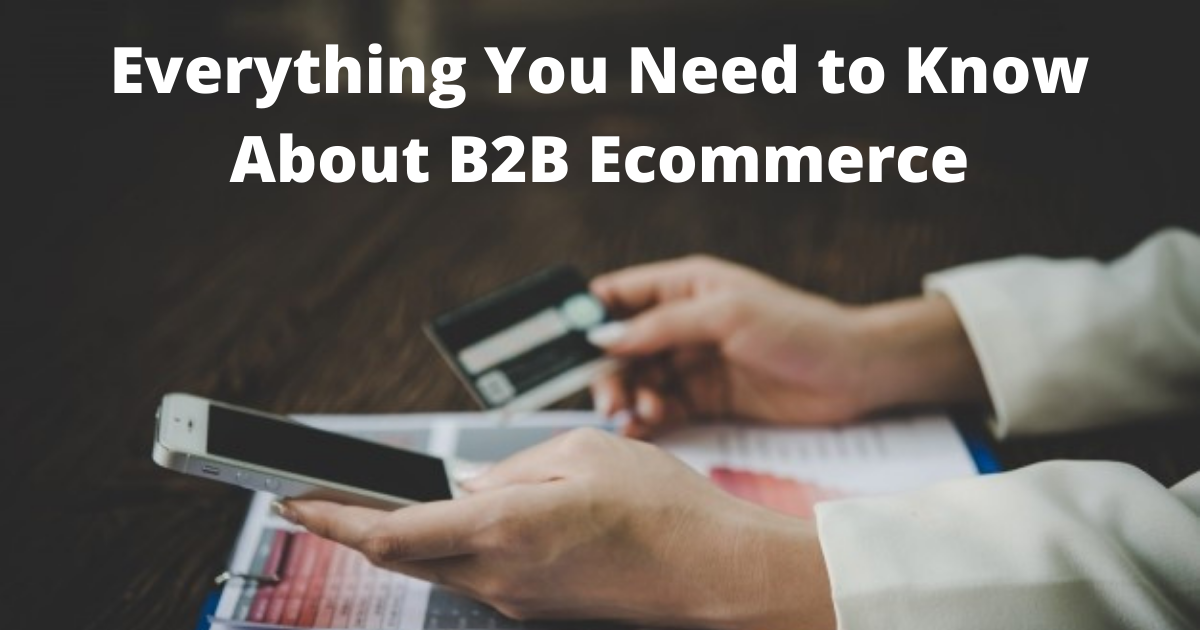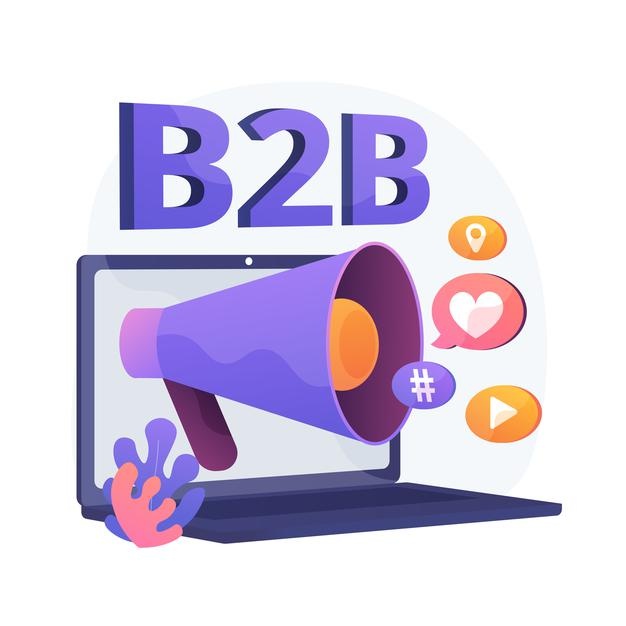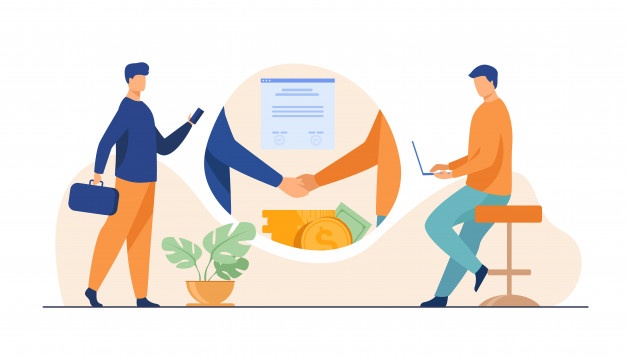Everything You Need to Know About B2B Ecommerce in 2022

The digital commerce business model is witnessing high adoption rates since COVID led to lockdowns and a temporary shutdown of brick and mortar stores. According to eMarketer, worldwide eCommerce sales will approach $5 trillion in 2021. The rise in B2C eCommerce businesses is evident, but how quickly B2B eCommerce is empowering the digital landscape is fascinating. The B2B buyers and sellers are gradually leaning towards digital platforms to self-evaluate products/services in a remote setup.
There was a time when B2B companies used to only sell offline and would work directly with suppliers by phone or face to face. Today, the scenario is quite different as 73% of B2B buyers are millennials who prefer the convenience of purchasing bulk orders online. This explains why even Amazon has been investing in developing its B2B eCommerce arm.
If you are new to the B2B e-commerce market, this guide will help you better understand how B2B eCommerce works, how to market to B2B customers, and which eCommerce platforms are the most B2B-friendly.
What Is B2B Ecommerce?

B2B eCommerce refers to processing orders for businesses or retailers, rather than sending orders directly to consumers. B2B orders are often purchased less often, sold in bulk, and shipped via freight (or parcel for smaller orders).
3 common types of B2B eCommerce businesses
B2B eCommerce takes up a lot of space in the market, and it consists of wholesalers, distributors, and suppliers. Here is a breakdown of the three most common types of B2B eCommerce businesses.
- Wholesalers
Wholesalers buy goods in bulk directly from manufacturers or distributors, and they resell them to other businesses (retailers and other wholesalers). Traditionally, a wholesale order occurred via calls or emails, but now it’s more common for wholesale orders to occur online through a designated eCommerce platform.
- Suppliers
Suppliers are B2B companies that are the source of goods in most eCommerce supply chains. Their immediate customers are distributors, who resell to wholesalers or retailers. Often, suppliers are confused with distributors. The main difference is that suppliers produce goods but don’t have the capacity and geographical reach to sell them. On the other hand, distributors have access to more channels.
- Distributors
Distributors procure goods from suppliers to sell to wholesalers and retailers, and they work closely with manufacturers. The greatest benefit of working with a distributor is they can easily help you expand your reach, even internationally.
For instance, if your brand is US-based, but you want to expand into Europe, you can find an international distributor that can connect with you with a large network of retail outlets in the regions you’re interested in and have a demand for your product.
What Is The Difference Between B2B and B2C eCommerce?
B2C stands for business-to-consumer eCommerce. As the name implies, in a B2C business setup, the business is the seller, and the end-user, or the consumer, is the buyer. There are no intermediary parties in between.
On the other hand, in a B2B business setup, the buyer and the seller are both business entities. The buyer may act as an intermediary, who can then sell the products/services to the end-users.
Approaching B2B and B2C buyers requires separate strategies due to the distinct buyer personas and the differences in the target audience’s mindset in each case.
Here are the 3 key differences between B2B and B2C eCommerce that you need to be aware of:
#1 Outreach
Whereas B2C purchases are usually made by one person, B2B sales usually require you to sell to teams of decision-makers. These decision-makers often come from different backgrounds, and therefore, have different needs and desires you must appeal to in order to win the deal. You must have collateral or content that speaks to each party’s needs and helps them see why buying from you can make it easier for them to do their job or achieve their business goals.
#2 Merchandising

Merchandising techniques vary based on B2C preferences; B2B customers are usually searching for specific features to serve as a comprehensive solution. The way you sell products, including messaging, up-and cross-selling techniques, and product information you highlight, will need to be customized for each customer segment.
For example, B2C customers may care more about buying a product that is of the highest quality, since they are buying in lower quantities. B2B customers, on the other hand, may seek a product that works within their company’s tight budget and provides easy recurring order set up. Your product may very well win in all of these categories, but you need to understand your buyers’ goals in order to include the key information that speaks to them.
#3 Pricing
Regardless of what you’re selling, your business customers are going to need a larger amount of it than your individual consumer base. You’ll also likely need to lower your prices to compete with wholesalers and other B2B sellers, which is why many B2B companies don’t make their pricing publicly available.
This opens up the opportunity for price customization, basing B2B pricing off of individual customers and situations, and maximizing your ROI on a case-by-case basis. There are options for implementing quote technology to streamline this portion of the sales process, or enabling customers to call in their orders the old-fashioned way.
Why Invest In A B2B Ecommerce Business?
If a business has an established B2C model for an eCommerce business, going B2B can be the next step forward to expand. On the other hand, if a business has an offline B2B setup, adopting the digital platform should be a priority to stay afloat (considering the impact of COVID-19 on businesses).
Why is B2B eCommerce Important?
- Maintain a competitive edge
- Improved brand visibility
- Expand B2B customer reach
- Fast-track order fulfillment
- Take advantage of analytics for insights
- Trim down the supply chain
- Offer platform for remote interaction
Benefits of Starting a B2B eCommerce Business
The major benefits of supporting a B2B eCommerce business model include:
- Expand Customer Reach
If a business already has a localized B2B eCommerce business, going online will help them expand their reach across borders. If they offer a good catalog, affordable and custom pricing, and a delightful customer experience — the business is likely to broaden its audience of target customers.
- Automated Sales Process
With the online platform, a business can easily automate the lengthy process involved in B2B sales. In addition, the communication among the sales team of respective suppliers, retailers, and distributors is synchronized and transparent, which further helps in streamlining the B2B transactions.
Top 10 Marketing & Growth Tips For B2B Ecommerce
In the competitive world of B2B giants, it can be difficult for a startup or mid-size eCommerce companies to develop the right B2B marketing strategies to remain competitive. Now that we have understood the characteristics and dynamics of B2B eCommerce, it’s time to walk through the best growth marketing strategies:
- Conduct thorough research on your prospects and clients
In-depth research can bring lots of valuable information to the surface, and you can then use this information for your B2B marketing. Better knowledge of your prospects and clients will empower you to deliver a better customer experience.
Besides, you will find out what helps your company succeed and develop a better understanding of the services that you should offer. When it comes to your prospects and clients, there is no such thing as useless data. Remember that, and collect as much as you can whenever you can to feed it back into your eCommerce optimization strategy.
- Create realistic marketing personas
Many B2C businesses create so-called “personas” when developing their marketing strategy. A marketing persona is a portrait of an average person that belongs to the company’s target audience, with as many details as possible, including the name, age, gender, interests, family, purchasing preferences, and behavior.
This tactic is also suitable for B2B marketing strategies, where your persona can be a business owner. This will help you save time by narrowing down your target audience and thus ensuring that your marketing message reaches the right recipients. It also helps with important aspects of your site that you might not be thinking about. If you know your target, you can write product content that addresses their pain points. You can choose a B2B eCommerce platform that integrates with systems your target customer already uses.
It goes deeper than just deciding who you’re selling to. It can inform the entire marketing strategy of your business.
- Keep your promises

Unfortunately, some sellers tend to use aggressive marketing tactics. They invest a lot into marketing, but their disappointed clients get hardly anything in the end. As a result, there is no ROI, the seller gets no profit and can ruin their reputation by promising things they know they can’t deliver.
This refers both to the business-to-consumer and business-to-business marketing strategies. So, to earn trust from your audience, and do not barrage them with unrealistic promises. Instead, just tell the truth and lay out clear expectations for your prospects about which problems your product can solve.
Never use loud words and phrases that are not supported by facts, such as “the best,” “award-winning,” or “number one.” Instead, keep your marketing collateral simple, clear, and trustworthy.
- Align your ads with landing pages
Landing pages should be a primary target of all marketing strategies for the business-to-business market. When a prospect clicks your ad, they should be taken to the dedicated, branded landing page with cohesive design and content.
If the content and design of the ad and landing page are completely different, the prospect is more likely to just leave the page altogether, and never be converted to a customer. As a result, you may be receiving lots of traffic to your landing page, but this traffic won’t be converting leads.
- Make your website appealing to visitors
This is arguably the most important marketing strategy for eCommerce. A user-friendly website with a sleek design and informative content will prolong the visits of your prospects and move them along the conversion funnel.
A responsive website with a mobile version will add even more points to your B2B marketing plans. Of course, it should also be user-friendly for your staff, so making sure you have a reliable system for product data management is key. Remember, service is part of user experience and you need to make sure your team keeps things streamlined internally.
- Encourage feedback
Feedback from customers is a powerful tool and an integral part of B2B web marketing. One of the best ways to gather feedback is to include surveys as part of your B2B marketing ideas.
This will help you understand your audience, improve your services and earn a shiny reputation because customers love it when their suggestions and feature requests are brought to life.
- Interconnect your sales channels
If you sell your products via a physical store, dedicated online store, and mobile app, you can go further and add more channels, such as social media or email marketing.
You can also use and integrate all of these channels with each other. This B2B internet marketing strategy will ensure a smooth, integrated customer experience across all of the channels available.
- Run A/B tests
A/B testing refers to testing two different B2B marketing tactics at the same time. Such tests are an important part of the best B2B marketing campaigns. To achieve better results, you should run them side by side and at the same time.
This will allow you to find out which business-to-business digital marketing campaign works better and detect possible errors.
- Run SEO campaigns
Search engine optimization is one of the best B2B marketing strategies. On-site SEO uses targeted keyword phrases that typically focus on your services and expertise.
The purpose of on-site SEO is to rank for searched terms on search engines, making it easier for your prospects to find you. Off-site SEO involves external links to your website, for example, guest posts on trusted websites. As a result, your website will earn more credibility with search engines.
- Find your brand advocates
Encourage your customers to share their positive experiences with your brand on social networks or review sites and reward them for this.
When people see that you appreciate such advocacy, they will be more likely to think of you in the future. Additionally, your employees can also become brand advocates.
Wrapping Up
B2B eCommerce is poised to gain significant ground over the next five years. While things have been disrupted at the moment, it won’t always be this way. Therefore, those who continue to invest in B2B eCommerce marketing strategies are positioning their business to increase their reach, visibility, sales, and market share, thereby potentially becoming a dominant force when things get back on track completely.
